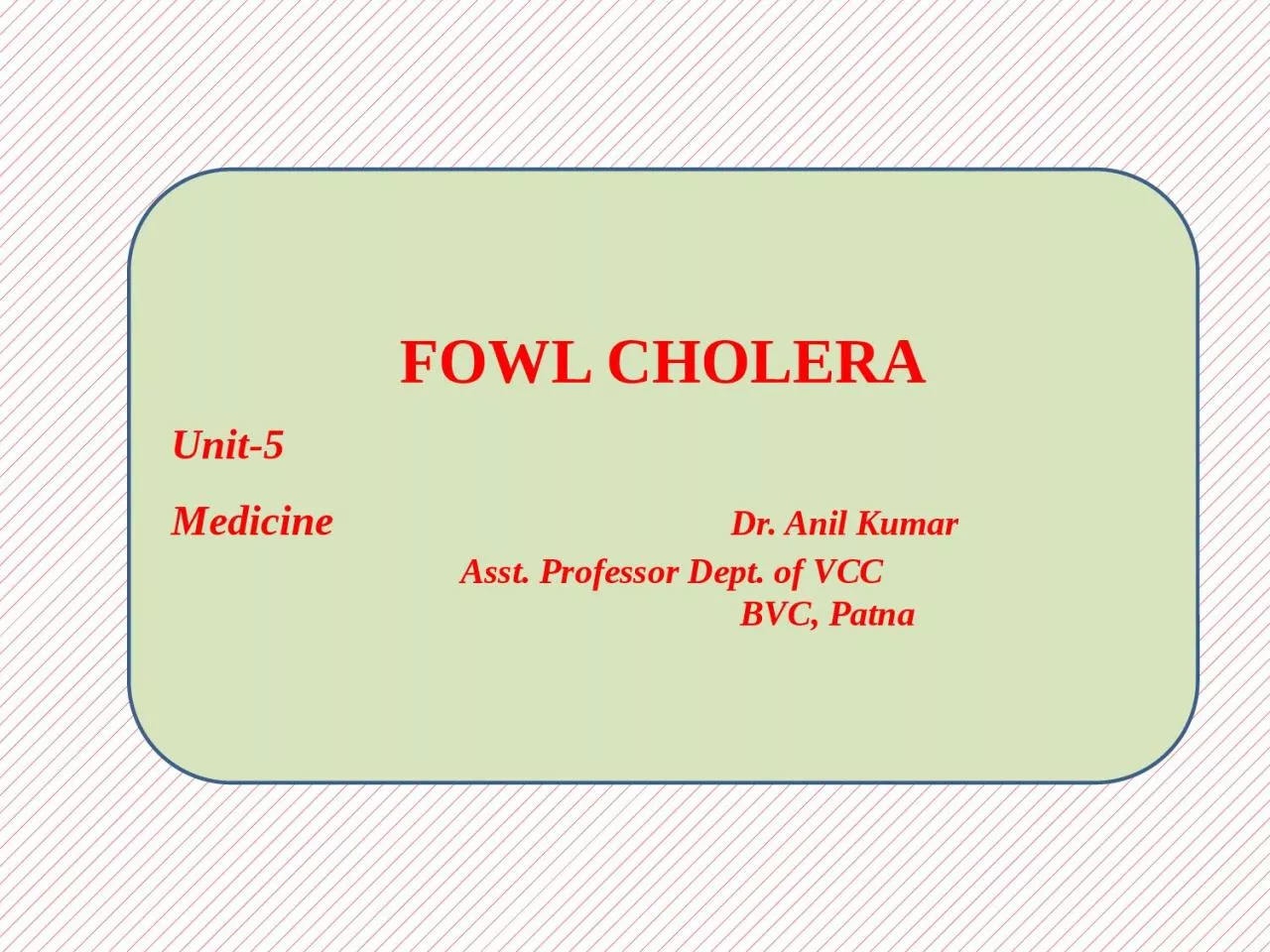/


Dr Anil Kumar Asst Professor Dept of VCC BVC Patna Fowl Cholera Avian pasteurellosis Avian choleraAvian ID: 1043211
Download Presentation The PPT/PDF document "FOWL CHOLERA Unit-5 Medicine" is the property of its rightful owner. Permission is granted to download and print the materials on this web site for personal, non-commercial use only, and to display it on your personal computer provided you do not modify the materials and that you retain all copyright notices contained in the materials. By downloading content from our website, you accept the terms of this agreement.
1. FOWL CHOLERAUnit-5 Medicine Dr. Anil Kumar Asst. Professor Dept. of VCC BVC, Patna
2. Fowl Cholera(Avian pasteurellosis/Avian cholera/Avian haemorrhagic septicaemia)Etiology: is a septicaemic disease (blood infection) of chickens.Pasteurella multocida subspecies multocida is the most common cause of disease, but subspecies septica and gallicida may also cause fowl cholera-like disease.Five capsular (A, B, D, E and F) and sixteen somatic (1-16) serovars of P. multocida are currently recognised . All but serotypes 8 and 13 have been isolated from avian hosts , as have capsular types A, B, D and F.Subspecies multocida and serovar A appear to be the most frequently isolated subspecies and serogroup from cases of the most severe form of fowl cholera.The capsule is regarded as a major virulence factor of avian P. multocida
3. Host Affected:All species of birds are susceptible, although turkeys are more so than fowl.Adult birds, or those in the late growing stage, are more frequently affected than younger stock.Source of transmission:carrier birdsclinically diseased poultry and their excretionscarcasses of birdsRats are also a reservoir for P. multocidaAirborne spread of infection does occur between pens, but spread through water and feed troughs is more importantPoultry may be infected by oral, nasal, and conjunctival routes, and through wounds
4. The virulence of disease is closely related to:The capsule is regarded as a major virulence factor of avian P. multocida, but other factors probably influence the outcome of infectionsOther virulence factor such as endotoxin/outer membrane proteins/iron binding systems /heat shock proteins/neuraminidase production/antibody cleaving enzymesSome stress factor like: Change of weather, fluctuation of temp, humidity, etc./ Move to new cage/ Debeaking/Alteration of food suddenly/ Exhaustion/ Over crowding/Transport in long time with lack of drink.Clinical signs: The main site of infection for P. multocida is the respiratory tract
5. Fowl cholera occurs in several forms: Per-acuteAcute,Chronic, and Localized diseaseIn the per-acute form: No warning signs and large numbers of birds are found dead, but in good bodily conditionBirds between I 2 and 18 weeks of age are most susceptible.In the acute form: Marked depression Anorexia Mucus discharge from the orifices Cyanosis and fetid (foul-smelling) Green watery diarrhoea Blue or purple coloration of skin and swelling of comb and wattles
6. In chronic infections: Localised infections of joints Abscesses of the head (cranial bones, infraorbital sinuses, subcutaneous tissue, comb and wattles), oviduct The respiratory tract (dyspnea and rales). Torticollis may be seen infections of the cranial bones, middle ear, and meninges.Postmortem FindingsIn severe form , marked congestion, pinpoint haemorrhages throughout the internal organs, and multiple necrotic areas (areas of dead tissue) in the liver.The liver may be enlarged and also show very small haemorrhages on the surface.laying hens free yolk may be present in the abdominal cavity.
7. In the less severe disease, oedema of the lungs (i.e., accumulation of fluid) and pneumonia (inflammation of lungs) are seen. In chronic cases, changes include arthritis (inflammation) of the hock and foot joints, and swelling of one or both wattlesliver shows tiny necrotic areas (minute white spots) on the surface. Note also streaks (lines) of light areasSwollen wattle characteristic of chronic cases of fowl cholera
8. Diagnosis;The history of the disease, symptoms and postmortem findings are helpful, but all forms of the disease can be confused with other infections. Demonstration of P. multocida confirms the diagnosis.At necropsy, bipolar microorganisms by the use of Wright’s or Giemsa staining of impression smears obtained from the liver in the case of acuteA polymerase chain reaction (PCR)Carrier status of a population of animals may also be investigated by the use of mouse inoculationsTreatment:Least value in severest formIn the less severe form, a number of drugs have proved effective. They include sulphonamides and antibiotics.In antibiotics, penicillin, streptomycin, oxytetracycline, chlortetracycline, and erythromycin have been used successfully.Recently, the fluoroquinolone, norfloxacin, has been shown to be effective against fowl cholera in chickens.
9. Control:Dispose of all birds and clean and disinfect the buildings thoroughly. Good management practices with emphasis on sanitation are the best means of preventing fowl cholera.The main source of infection is the sick bird, or those that have recovered but still carry the organism.Only young birds should be introduced as new stock.They should be raised in a clean environment completely isolated from other birds.Vaccination should be considered in areas where fowl cholera is prevalent, but it should not be substitute for good sanitary practiceInactivated bacterins and live attenuated vaccinesBacterins are widely used, but only induce immunity to homologous serotypesLive vaccines are normally given as wing web inoculations to chickens and via drinking water to turkeys